Foot & Ankle
Foot and Ankle Anatomy
The foot and ankle are a complex joint involved in movement and providing stability and balance to the body. The foot and ankle consist of 26 bones, 33 joints, and many muscles, tendons and ligaments.
Bones of the Ankle
The ankle joint connects the leg with the foot and is composed of three bones: tibia, fibula and talus. The tibia or shinbone and fibula or calf bone are bones of the lower leg which articulate with the talus or ankle bone, enabling up and down movement of the foot.
Three bony bumps present on the ends of the tibia and fibula form parts of the ankle joint:
- The medial malleolus, formed by the tibia, is found on the inside of the ankle.
- Posterior malleolus, also formed by the tibia, is found at the back of the ankle.
- Lateral malleolus, formed by the fibula, is found on the outer aspect of the ankle.
Bones of the Feet
The foot acts as a single functional unit, but can be divided into three parts: the hindfoot, midfoot and forefoot.
The hindfoot forms the ankle and heel and is made up of the talus bone and calcaneus or heel bone. The heel bone is the largest bone in the foot.
The midfoot connects the hindfoot to the forefoot, and consists of one navicular bone, one cuboid bone, and three cuneiform bones. The navicular bone is found in front of the heel bone, and the cuneiform and cuboid bones are arranged in front of the navicular bone.
These bones are connected to five metatarsal bones of the forefoot, which form the arch of the foot for shock absorption while walking or running. The forefoot is also made up of the toes or digits, formed by phalanges, three in each toe, except the big toe, which has only two phalanges. The big toe has two additional tiny round sesamoid bones in the ball of the foot, which help in upward and downward movement of the toe.
Ankle and Foot Joints
There are 33 joints in the ankle and foot. They include:
- Hinge joints in the ankle, which allow flexion (bending) and extension
- Gliding joints found in the hindfoot, which allow gliding movements
- Condyloid joints found in the forefoot and toes, which allow the flexion (bending) and extension, adduction and abduction (sideward movement).
The joints of the foot and ankle provide stability and support the weight of the body, helping you to walk or run, and to adapt to uneven ground.
The joint surface of all bones of the ankle and foot are lined by a thin, tough, flexible, and slippery surface called articular cartilage, which acts as a shock absorber and cushion to reduce friction between the bones. The cartilage is lubricated by synovial fluid, which further enables smooth movement of the bones.
Soft Tissues of the Ankle and Foot
Our feet and ankle bones are held in place and supported by various soft tissues such as cartilage, ligaments, muscles, tendons and bursae.
Cartilage is the flexible, shiny, smooth tissue on the ends of bones that meet to form a joint. Cartilage provides cushioning between the bones allowing smooth movement.
Ligaments are tough rope-like tissue that connect bones to other bones, and holds them in place providing stability to the joints. The plantar fascia is the largest ligament in the foot, originating from the heel bone to the forefoot, it extends along the bottom surface of the foot and is involved in maintaining the arch of the foot. The plantar fascia ligament stretches and contracts to provide balance and strength to the foot. Lateral ligaments on the outside of the foot and medial ligaments on the inside of the foot provide stability and allow up and down movement of the foot.
The foot is made up of 20 muscles, which help in movement. The main muscles include:
- Anterior tibial muscle: allows up and down movement of the foot
- Posterior tibial muscle: supports the arch
- Peroneal tibial muscle: controls movement on the outside of the ankle
- Extensors: enable the ankle to raise the toes just before stepping forward
- Flexors: stabilize the toes against the floor
- Smaller muscles are also present to help the toes lift and curl.
Tendons are soft tissues that connect muscles to bones. The largest and strongest tendon in the foot is the Achilles tendon, present at the back of the lower leg around the heel bone. Other tendons include peroneal and anterior and posterior tibialis.
Bursae
Bursae are small fluid-filled sacs that decrease friction between tendons and bone or skin. Bursae contain special cells called synovial cells that secrete a lubricating fluid.
Soft Tissue Injury or Abnormality
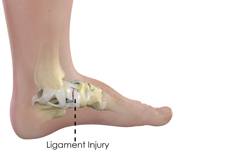
Ligament
A sprain is stretching or tearing of a ligament. Ligaments connect adjacent bones in a joint and provide stability to the joint.An ankle sprain is a common injury and occurs when you fall or suddenly twist the ankle joint or when you land your foot in an awkward position after a jump.
General Tendon Injury

Tendonitis
Tendonitis refers to the inflammation of a tendon, which is a band of fibrous connective tissue that attaches a muscle to a bone. Tendinitis can result from repetitive or overuse injury of the tendon and can occur during activities such as gardening, carpentry, shoveling, painting, scrubbing, tennis, golf, skiing, and pitching.

Tear
The anterior cruciate ligament, or ACL, is one of the major ligaments of the knee that is located in the middle of the knee and runs from the femur (thigh bone) to the tibia (shin bone). It prevents the tibia from sliding out in front of the femur.
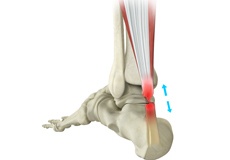
Achilles Tendon Rupture
Achilles tendon is a strong fibrous cord present behind the ankle that connects the calf muscles to heel bone. It is used when you walk, run and jump. When the Achilles tendon becomes thin, weak, or if it is not used, it may be susceptible to injury or damage.

Plantar Fasciitis
Plantar fasciitis refers to inflammation of the plantar fascia, a thick band of tissue that lies at the bottom of the foot. It runs from the heel bone to the toe and forms the arch of your foot. Plantar fasciitis is one of the most common painful foot conditions. It is most often seen in middle-aged men and women.

Morton’s Neuroma
Morton’s neuroma refers to a nerve injury between the toes, usually the third and fourth toes, which causes pain and thickening of the nerve tissue. Compression or chronic irritation of this interdigital nerve is the main cause of Morton’s Neuroma.
Intra-articular Injury or Abnormality
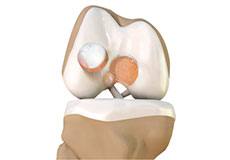
Cartilage Restoration
Articular Cartilage is the white tissue lining the end of bones where these bones connect to form joints. Cartilage acts as cushioning material and helps in smooth gliding of bones during movement. An injury to the joint may damage this cartilage which cannot repair on its own. Cartilage can be damaged with increasing age, normal wear and tear, or trauma.

Osteochondral Injury
Osteochondral injuries are one of the most common causes of ankle pain. Though in a majority of cases there is a history of injury or trauma to the ankle joint, a few cases may not have any previous history of ankle injury. A condition known as osteochondritis dissecans is commonly seen in the knee and ankle joint and is characterized by the damage and separation of a piece of bone and cartilage, within the joint, from the underlying bone.

Loose Body
Loose bodies are small loose fragments of cartilage or a bone that float around the joint. The loose bodies can cause pain, swelling, locking and catching of the joint. Loose bodies occur if there is bleeding within the joint, death of tissueslining the joints associated with tuberculosis, osteoarthritis and rheumatoid arthritis.
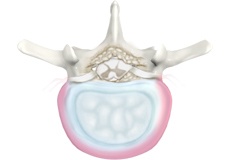
Degenerative Disease
Arthritis is inflammation resulting from the degeneration of cartilage in the joint causing pain, swelling, and stiffness in the joints resulting in restricted movements. Arthritis of the foot and ankle joint can occur due to fracture, dislocation, inflammatory disease, or congenital deformity.
Trauma
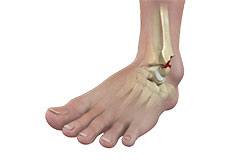
Ankle Fracture
Ankle injuries are the most common sports-related injury. An ankle fracture is a break in one or more bones that make up the ankle joint. Sometimes ligaments may also be damaged.
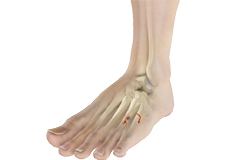
Foot Fractures
A stress fracture is described as a small crack in the bone which occurs from an overuse injury of a bone. It commonly develops in the weight bearing bones of the lower leg and foot. When the muscles of the foot are overworked or stressed, they are unable to absorb the stress
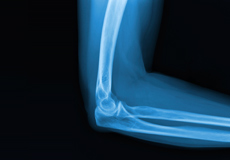
Pilon (Distal Tibial Articular) Fracture
Coming soon










